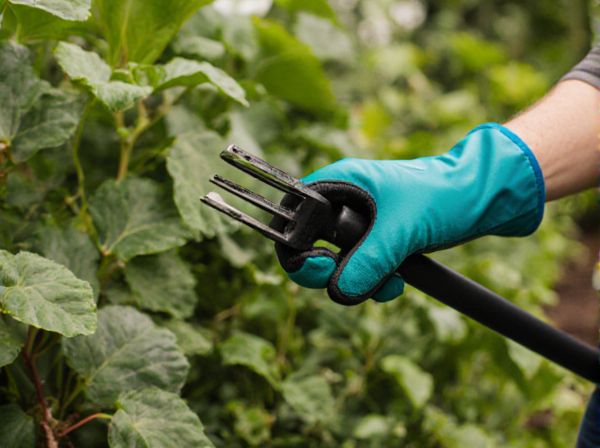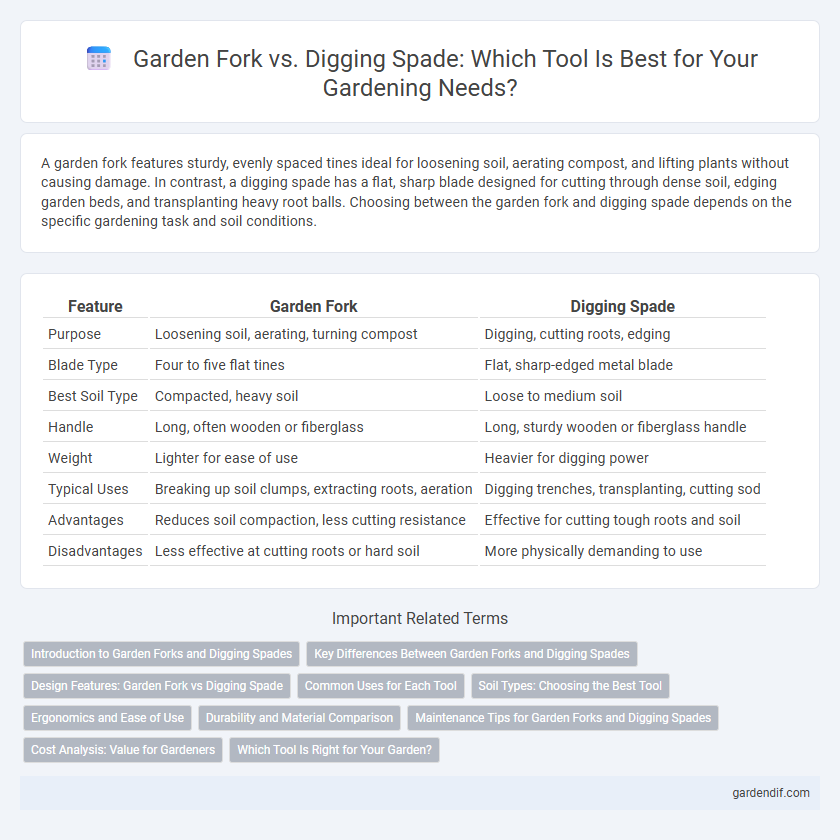
Garden fork vs digging spade Illustration
A garden fork features sturdy, evenly spaced tines ideal for loosening soil, aerating compost, and lifting plants without causing damage. In contrast, a digging spade has a flat, sharp blade designed for cutting through dense soil, edging garden beds, and transplanting heavy root balls. Choosing between the garden fork and digging spade depends on the specific gardening task and soil conditions.
Table of Comparison
| Feature | Garden Fork | Digging Spade |
|---|---|---|
| Purpose | Loosening soil, aerating, turning compost | Digging, cutting roots, edging |
| Blade Type | Four to five flat tines | Flat, sharp-edged metal blade |
| Best Soil Type | Compacted, heavy soil | Loose to medium soil |
| Handle | Long, often wooden or fiberglass | Long, sturdy wooden or fiberglass handle |
| Weight | Lighter for ease of use | Heavier for digging power |
| Typical Uses | Breaking up soil clumps, extracting roots, aeration | Digging trenches, transplanting, cutting sod |
| Advantages | Reduces soil compaction, less cutting resistance | Effective for cutting tough roots and soil |
| Disadvantages | Less effective at cutting roots or hard soil | More physically demanding to use |
Introduction to Garden Forks and Digging Spades
Garden forks feature sturdy, evenly spaced tines designed for aerating soil, lifting roots, and breaking up dense earth, making them ideal for cultivating garden beds. Digging spades have a flat, sharp-edged blade suited for cutting into soil, edging lawns, and digging precise holes, offering greater control for digging tasks. Both tools serve complementary purposes in garden maintenance, enhancing soil preparation and planting efficiency.
Key Differences Between Garden Forks and Digging Spades
Garden forks feature sturdy, widely spaced tines ideal for loosening soil and aerating compost, while digging spades have flat, sharp blades designed for cutting through tough soil and roots. The garden fork's design allows for lifting and turning soil without compacting, enhancing soil structure, whereas the digging spade excels in precision digging and edging tasks. Both tools serve essential but distinct functions in gardening, with their differences rooted in blade shape, purpose, and soil interaction.
Design Features: Garden Fork vs Digging Spade
Garden forks feature sturdy, widely spaced tines designed to loosen soil, aerate compost, and remove weeds without damaging plant roots. Digging spades have a flat, sharp-edged blade ideal for cutting through dense soil, digging trenches, and transplanting. The fork's open design enables soil to fall through, while the spade's solid blade provides precision and leverage for digging tasks.
Common Uses for Each Tool
Garden forks excel at loosening, aerating, and turning soil in vegetable beds or compost piles, making them ideal for breaking up dense clay or heavy soil. Digging spades are designed for cutting through soil and roots with their sharp, flat blades, suitable for planting, edging, and digging trenches. While garden forks preserve soil structure during aeration, digging spades enable precise excavation and soil removal for landscaping tasks.
Soil Types: Choosing the Best Tool
Garden forks excel in loosening heavy clay and compacted soil without causing damage, making them ideal for dense, rocky ground. Digging spades perform best in lighter, sandy, or loamy soils where precise digging and clean edges are needed. Selecting the appropriate tool based on soil type enhances efficiency and protects soil structure during gardening tasks.
Ergonomics and Ease of Use
Garden forks feature long, sturdy tines that reduce soil resistance, minimizing wrist strain and enhancing ergonomic comfort during digging and turning tasks. Digging spades typically have a flat, broad blade designed for cutting through compacted soil but may require more wrist strength and exertion, impacting ease of use over extended periods. Ergonomically designed garden forks offer better leverage and control, making them preferable for users seeking reduced fatigue and improved efficiency in garden soil management.
Durability and Material Comparison
Garden forks typically feature tines made of hardened steel, offering superior durability and resistance to bending compared to digging spades, which often have broader blades made of carbon steel prone to edge wear. The thicker, reinforced construction of garden forks allows them to withstand heavy, rocky soil conditions without compromising structural integrity. In contrast, digging spades prioritize sharpness and penetration, so their materials are designed for cutting efficiency but require more frequent maintenance to prevent corrosion and wear.
Maintenance Tips for Garden Forks and Digging Spades
Regular cleaning and drying of garden forks and digging spades prevent rust and prolong tool life, with sharpened edges enhancing digging efficiency. Applying a light coat of oil to metal parts after use reduces corrosion risks, while wooden handles benefit from occasional sanding and linseed oil treatment to maintain strength and prevent splintering. Proper storage in a dry, ventilated area further protects these essential gardening tools from environmental damage.
Cost Analysis: Value for Gardeners
Garden forks typically cost between $30 and $70, offering durability and versatility for aerating soil and removing weeds, making them a cost-effective choice for long-term garden maintenance. Digging spades, priced around $25 to $60, provide precise soil cutting and edging, ideal for gardeners focused on detailed planting tasks. Budget-conscious gardeners seeking multi-purpose tools often find garden forks deliver superior value, while those requiring specialized digging may prioritize the spade despite a slightly lower cost.
Which Tool Is Right for Your Garden?
Choosing between a garden fork and a digging spade depends on your soil type and gardening tasks; garden forks excel in loosening heavy, compacted soil without damaging plant roots, while digging spades are ideal for cutting through tough soil and transplanting. Garden forks provide aeration and help break up clods, making them perfect for preparing beds and handling root crops. Spades offer precision for edging and digging holes, ensuring efficient planting and soil management in various garden environments.
Garden fork vs digging spade Infographic

 gardendif.com
gardendif.com